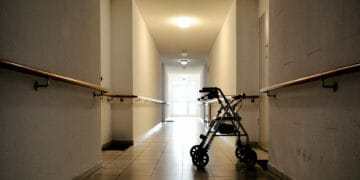Spurred by decades of complaints about the high cost of hearing aids, Congress passed a law in 2017 to allow over-the-counter sales, with hopes it would boost competition and lower prices.
Four years later, federal regulators have yet to issue rules to implement the law. But changes in the industry are offering consumers relief.
In August 2017, President Donald Trump signed the legislation that called for the Food and Drug Administration to issue regulations by 2020 for hearing aids that could be sold in stores without a prescription or a visit to an audiologist or other hearing specialist. That hasn’t happened yet, and President Joe Biden last month ordered the FDA to produce those rules for over-the-counter (OTC) purchases by mid-November. That means it will likely take at least until next summer for consumers to feel the direct effects of the law.
Despite the delay, consumers’ options have expanded with more hearing devices entering the market, alternative ways to get them and lower prices, particularly for the largest segment of the population with impaired hearing — those with mild to moderate hearing loss, for whom the law was intended.
Leading consumer brands Apple and Bose are offering products and several smaller companies sell aids directly to consumers, providing hearing tests and customer service online from audiologists and other hearing specialists. Even major retailers offer hearing aids directly to consumers and provide audiology services online: Walgreens stores in five Southern and Western states sell what the chain calls “FDA-registered” Lexie hearing aids for $799 a pair — far less than half the price of typical devices.
Nationally, personal sound amplification products, or PSAPs, that are smaller and customizable are now available in stores and online. These devices, which look like hearing aids and sell for a fraction of the price, amplify sounds, but some do not address other components of hearing loss, such as distortion.
“There are many more options than there were in 2017 when Trump signed the Hearing Aid Act into law,” said Nancy Williams, president of Auditory Insight, a hearing industry consulting firm in New Haven, Connecticut. “In a sense, you can say the OTC revolution is happening without the FDA, but the difficulty is it is happening more slowly than if the FDA issued its rules on time.”
The price for a pair of standard hearing aids typically ranges from $2,000 to $8,000, depending on the technology. That price includes the professional fitting fees and follow-up visits. The hearing aid industry has remained largely insulated from price competition because of consolidation among manufacturers, widespread state licensing laws that mandate sales through audiologists or other hearing professionals, and the acquisition of hearing professionals’ practices by device makers.
The federal law creates a category of hearing aids that would legally bypass state dispensing laws and enable consumers to buy aids in stores without consulting a hearing aid professional. Users would be expected to program the devices through a smartphone, and companies could offer service via phone or internet.
With an increasing number of hearing aids and PSAPs being sold directly to consumers, advocates are eager for the FDA rules to come out, because they worry about the confusion caused by the array of choices — with none having the FDA’s full seal of approval.
“The FDA delaying regulations has done more harm than good, because the direct-to-consumer market is filling the void and people are doing what they want, and we don’t know the quality of these devices,” said Barbara Kelley, executive director of the Hearing Loss Association of America, a consumer advocacy group.
The law, sponsored by Sen. Elizabeth Warren (D-Mass.), gave the FDA until August 2020 to issue regulations. Last year, after missing that deadline, FDA officials said the covid-19 pandemic had delayed the rule-making process.
Many in the hearing aid industry are concerned about the unchecked competition likely to come with allowing consumers to buy aids on their own without an evaluation by a hearing specialist.
Brandon Sawalich, CEO of Starkey, the largest U.S.-based hearing aid company, said consumers need expert assistance to test their hearing, buy an appropriate aid, properly fit it and fine-tune its settings.
“It’s not just picking up something off the shelf at your local drugstore or ordering something online and putting it in your ear and your life is going to be reconnected and you are going to hear perfectly again,” he said on a recent podcast. “It doesn’t work that way, and it’s not that easy.”
However, by avoiding professional help, more Americans likely can get hearing assistance. “The OTC and direct-to-consumer options open up avenues for those who have no other path to get hearing aids,” said Hope Lanter, a Charlotte, North Carolina, audiologist with Hear.com, a Netherlands-based online hearing aid retailer.
She expects that after the FDA issues its rules many hearing aid manufacturers will develop lower-cost, over-the-counter devices that can be obtained without an audiologist’s evaluation. She said consumers with modest hearing loss may start out with those types of aids, but later, if their hearing worsens, shift to more expensive devices that require assistance from hearing aid professionals.
“In my view, there is enough pie for everyone,” Lanter said, noting that millions of people with hearing loss are not getting any help today. More than 37 million American adults have trouble hearing, including nearly half of people over age 60. Only 1 in 4 adults who could benefit from a hearing aid have ever used one, federal health officials estimate.
Unlike most consumer electronics, hearing aids have remained expensive for decades, generating consumer complaints.
The price is concerning because Medicare and many insurers don’t cover hearing aids, though most private Medicare Advantage plans do. Only about half of state Medicaid programs cover the devices, but benefits in those states vary widely, according to data from KFF.
Industry experts predict new over-the-counter hearing aids will be priced at less than $1,000 a pair — about 25% lower than low-cost retailer Costco sells its Kirkland aids, dispensed through a hearing aid professional.
Without federal rules in place, manufacturers have largely waited to develop devices for the OTC market.
Bose chose a different path. This spring it began selling its hearing aids, which can be purchased online without a doctor visit, hearing test or prescription. Bose gained FDA clearance in 2018 after providing data showing the effectiveness of its self-fitting aids was comparable to that of similar devices fitted by a hearing professional. The Bose aids sell for $849 a pair.
Meanwhile, Apple last year integrated hearing assistance into its popular Air Pods Pro earbuds, which can be customized using settings on an iPhone. Apple is not marketing the free benefit as a hearing aid but instead as similar to a PSAP that amplifies sound to help hearing.
Several companies such as Eargo, Lively and Lexie allow consumers to buy aids online and get help from specialists to set them up remotely. As long as companies have generous return policies that enable people to try a couple of aids to see which works best, the proliferation of online options selling high-quality aids is good news for consumers, said Williams, the Connecticut hearing consultant.
Lanter said the stigma around hearing aids will be reduced as people obtain them more easily. She predicted consumers will someday buy hearing aids much as they can buy inexpensive reading eyeglasses at the drugstore today with the option to get a prescription for higher-quality glasses or ones with a more precise fit.
Michelle Arnold, an audiologist and assistant professor at the University of South Florida, said there is no evidence consumers will be harmed buying a hearing aid without seeing an audiologist, and the benefits of getting some improvement in their hearing outweigh any risks. “Will people get the maximum benefit? Maybe not, but it’s better than nothing,” she said.
KHN (Kaiser Health News) is a national newsroom that produces in-depth journalism about health issues. Together with Policy Analysis and Polling, KHN is one of the three major operating programs at KFF (Kaiser Family Foundation). KFF is an endowed nonprofit organization providing information on health issues to the nation.

















